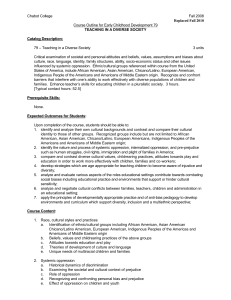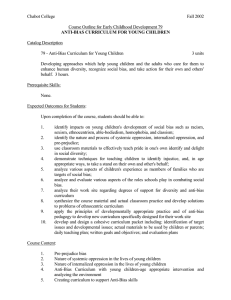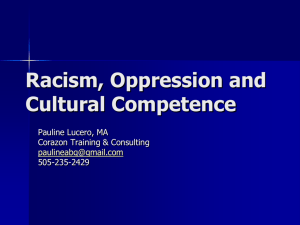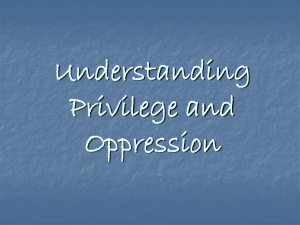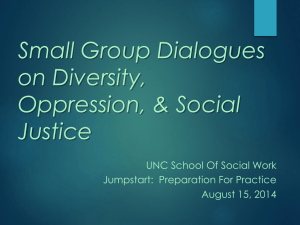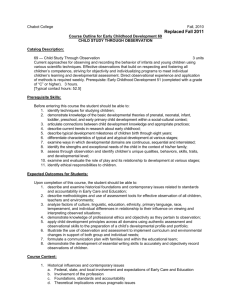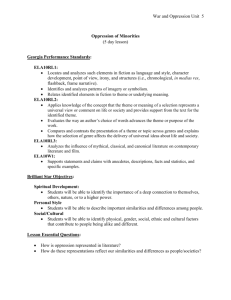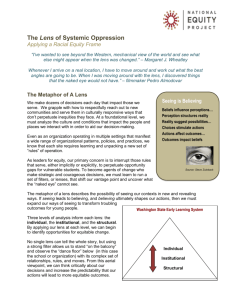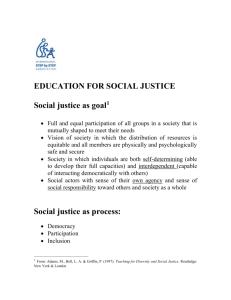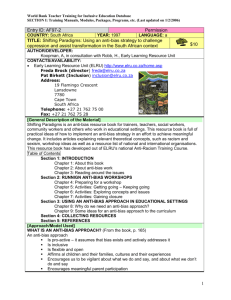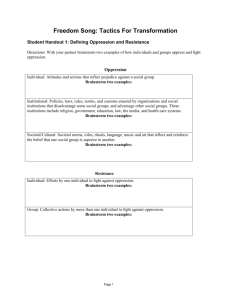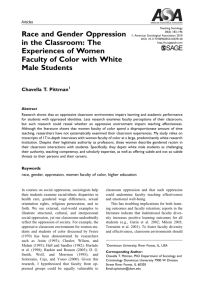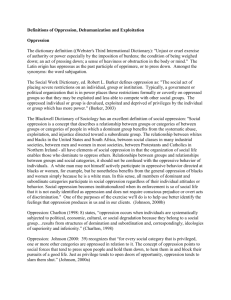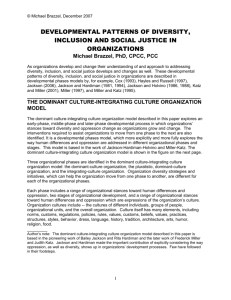Teaching in a Diverse Society
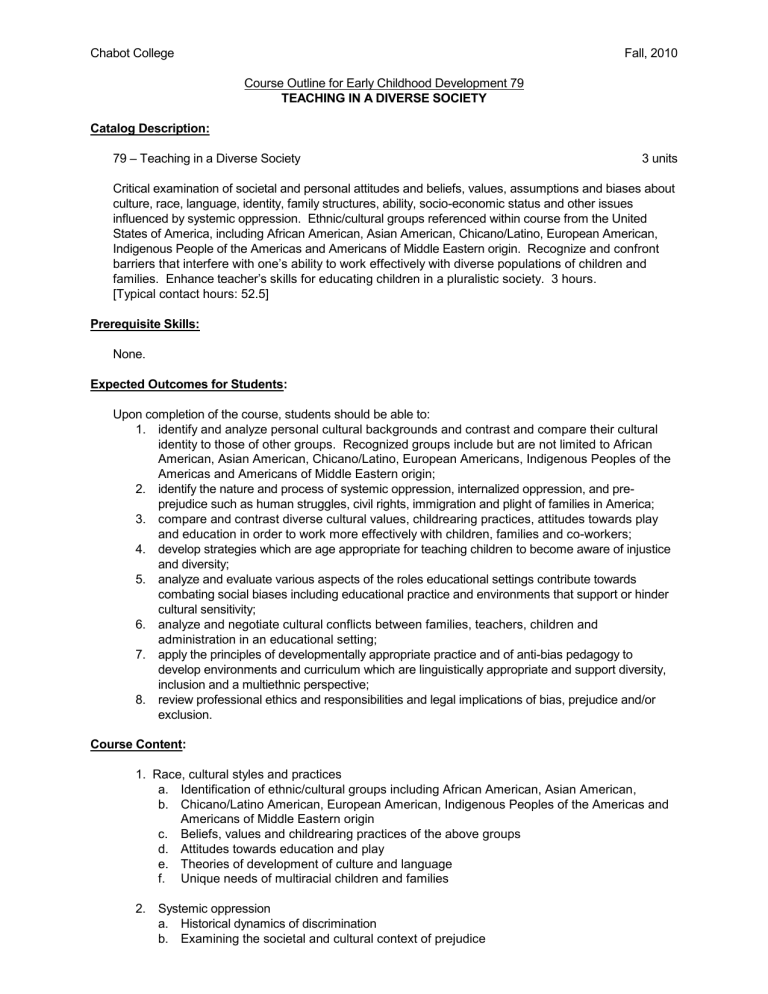
Chabot College
Course Outline for Early Childhood Development 79
TEACHING IN A DIVERSE SOCIETY
Catalog Description:
79 – Teaching in a Diverse Society
Fall, 2010
3 units
Critical examination of societal and personal attitudes and beliefs, values, assumptions and biases about culture, race, language, identity, family structures, ability, socio-economic status and other issues influenced by systemic oppression. Ethnic/cultural groups referenced within course from the United
States of America, including African American, Asian American, Chicano/Latino, European American,
Indigenous People of the Americas and Americans of Middle Eastern origin. Recognize and confront barriers that interfere with one’s ability to work effectively with diverse populations of children and families. Enhance teacher’s skills for educating children in a pluralistic society. 3 hours.
[Typical contact hours: 52.5]
Prerequisite Skills:
None.
Expected Outcomes for Students:
Upon completion of the course, students should be able to:
1. identify and analyze personal cultural backgrounds and contrast and compare their cultural identity to those of other groups. Recognized groups include but are not limited to African
American, Asian American, Chicano/Latino, European Americans, Indigenous Peoples of the
Americas and Americans of Middle Eastern origin;
2. identify the nature and process of systemic oppression, internalized oppression, and preprejudice such as human struggles, civil rights, immigration and plight of families in America;
3. compare and contrast diverse cultural values, childrearing practices, attitudes towards play and education in order to work more effectively with children, families and co-workers;
4. develop strategies which are age appropriate for teaching children to become aware of injustice and diversity;
5. analyze and evaluate various aspects of the roles educational settings contribute towards combating social biases including educational practice and environments that support or hinder cultural sensitivity;
6. analyze and negotiate cultural conflicts between families, teachers, children and administration in an educational setting;
7. apply the principles of developmentally appropriate practice and of anti-bias pedagogy to develop environments and curriculum which are linguistically appropriate and support diversity, inclusion and a multiethnic perspective;
8. review professional ethics and responsibilities and legal implications of bias, prejudice and/or exclusion.
Course Content:
1. Race, cultural styles and practices a. Identification of ethnic/cultural groups including African American, Asian American, b. Chicano/Latino American, European American, Indigenous Peoples of the Americas and
Americans of Middle Eastern origin c. Beliefs, values and childrearing practices of the above groups d. Attitudes towards education and play e. Theories of development of culture and language f. Unique needs of multiracial children and families
2. Systemic oppression a. Historical dynamics of discrimination b. Examining the societal and cultural context of prejudice
Chabot College
Course Outline for Early Childhood Development 79, Page 2
Fall, 2010 c. Role of oppression d. Recognizing and confronting personal bias and prejudice e. Effect of oppression on children and youth
3. Self/group identity issues as they relate to self-image and social justice a. Racial characteristics and physical similarities and differences b. Disabilities c. Gender identity and life style choices d. Changing family structures e. Cultural and ethnic similarities and differences f. Class and economic issues
4. Dealing with exclusion, discrimination and stereotyping a. Development of empathy in young children b. Concept of inequity, fairness and equality c. Personal discomfort d. Recognizing stereotypes in community, media and classroom environment e. Developing children’s self-confidence and assertiveness in resisting discrimination and exclusion f. Negotiating conflict and cultural differences
5. Rational for curriculum that reflects diversity a. Children’s identity and attitude formation as part of development b. Contrast of anti-bias work vs. multiculturalism and traditional curriculum c. Teacher responsibility to confront oppression and empower all children d. Interactions and communication between adults and children e. Including families in curriculum implementation and evaluation
6. Teachers role in implementing curriculum rich in diversity and multi ethnicity a. Understanding root of cultural identities b. Creating community support systems for a diverse classroom c. Evaluating and assessing the environment d. Selection of materials and equipment which support diversity and multi ethnicity e. Examination of holidays within a diverse classroom f. Integrati on of children’s cultural backgrounds and language into classroom environments g. Working together with families for equitable decision making
7. Professional ethics and responsibilities a. NAEYC code of Ethical Behavior b. Legal implications of bias, prejudice, and/or exclusion
Methods of Presentation:
1. Lecture and discussion
2. Films and tapes
3. Guest speakers
4. Student reports
5. Projects and other assignment
6. Interviews
Assignments and Methods of Evaluating Student Progress:
1. Typical Assignments: a. Write down all the st ereotypes and jokes they have heard about “visible minority,”
Chabot College
Course Outline for Early Childhood Development 79, Page 3
Fall, 2010 immigrants, aboriginal people, disabled people, women or other groups. Later, you will write a reflective report on how these stereotypes may affect children of these cultures and their overall development. b. Write a three-five page essay reflecting on a career in early childhood education and teaching in a diverse classroom. c. Interview someone who is other than your own cultural background on child rearing practices, education, and family roles and responsibilities. d. Read several related articles and write a reflective response for each of the articles including your own personal experiences and opinions. e. Create a developmentally and culturally appropriate activity plan.
2. Methods of Evaluating Student Progress: a. Attendance and participation b. Assignments and reports c. Interview d. Midterm e. Final Examination
Textbook(s) (typical):
Anti-Bias Curriculum,
Children, 2001*
by Louise Derman-Spark, National Association for the Education of Young
Skilled Dialogue: Strategies for Responding to Cultural Diversity in Early Childhood.
Barrear, I &
Corso, R.M
. Baltimore Paul Brooks. 2003.*
Knowing and Serving Diverse Families, V Hildebrand, P Aotaki, L McPhail Gray and R Pena-Hines,
3 rd edition. New York, Pearson Merrill-Prentice Hall, 2008
Diversity in Early Care and Education: Honoring Differences, Janet Gonzalez-Mena, 5 th edition New
York, McGraw Hill, 2008
* These texts are by well regarded experts in the early childhood field. The information is presented in accessible and understandable terms that will be useful to students.
Special Student Materials :
None.
ECD 79, revised 9/09: cs
